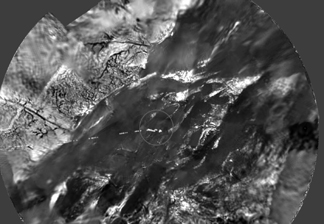 Ever since the
Huygens probe made its January 2005 descent through the atmosphere of Titan,
Saturn’s largest moon, researchers have been analyzing data transmitted
back to Earth, which provided the first close-up view of the moon’s surface
that lurks below its dense orange-colored atmosphere. That surface, scientists
are finding, is riddled with river channels, lakebeds, volcanoes and erosion
patterns, possibly carved by recurring methane rains. And chemical analyses
of the atmosphere are suggesting that methane gas there most likely does not
originate from a biological source, as some researchers previously proposed.
Ever since the
Huygens probe made its January 2005 descent through the atmosphere of Titan,
Saturn’s largest moon, researchers have been analyzing data transmitted
back to Earth, which provided the first close-up view of the moon’s surface
that lurks below its dense orange-colored atmosphere. That surface, scientists
are finding, is riddled with river channels, lakebeds, volcanoes and erosion
patterns, possibly carved by recurring methane rains. And chemical analyses
of the atmosphere are suggesting that methane gas there most likely does not
originate from a biological source, as some researchers previously proposed.
Linear markings in this image of Titan’s surface represent channels, which could imply the occurrence of methane rain. The channels were dry during the Huygens probe’s landing on this Saturnian moon in January 2005, but the region could experience periods of dry and wet seasons like those on Earth. Image courtesy of ESA/NASA/JPL/University of Arizona.
Prior to Huygens’ arrival on Titan, astronomers determined from images from ground-based telescopes and the Hubble Space Telescope that Titan, like Earth, has a nitrogen-based atmosphere. They also learned, however, that Titan’s atmosphere contains a significant amount of methane, which is periodically replenished by an unknown mechanism. Some researchers suggested that methane-producing life could be responsible.
But according to Hasso Niemann of NASA’s Goddard Space Flight Center in Greenbelt, Md., and colleagues, carbon isotope values in the methane do not support the life hypothesis. Writing in a Nov. 30 Nature online paper, they suggest instead that methane is supplied by a geological source — likely from an underground methane reservoir.
Martin Tomasko, a research professor at the University of Arizona’s Lunar and Planetary Laboratory in Tucson, agrees, and thinks that the underground methane could actually be close to the surface. When Huygens touched down on Titan, Niemann and colleagues noted in their paper, methane signals increased, probably from liquid methane melted by the impact mixing with surface materials. Then, 50 minutes later, the methane signal decreased, probably as it evaporated into the atmosphere, much as water acts on Earth, they wrote.
Although an October 2004 Cassini flyby of Titan ruled out the presence of large standing bodies of liquid methane on the surface, Tomasko says that Huygens’ images, taken only kilometers above the surface, reveal that recurring methane rains have shaped Titan’s Earth-like surface patterns. Taken from between 17 and 18 kilometers above the ground, the images reveal a complex network of channels, which drain from high, light-colored elevations to low, dark-colored flatlands. The channels were dry at the time of landing, Tomasko says, and there’s no telling how often weather systems bring methane rains, which would drain through the channels. But he says that such storms could be frequent, considering that some channel walls slope at a steep 30 degrees and have not had time to erode from wind.
The idea that methane “wetted” Titan sometime in the past is “a pretty safe conclusion,” says Randolph Kirk, a geophysicist with the U.S. Geological Survey’s Astro-geology Team in Flagstaff, Ariz. Kirk compiles stereo images from the data to create surface maps, which he hopes will help to determine the rates that Titan’s hills are built and eroded. Receiving images from the surface of the “new world,” Kirk says, “couldn’t possibly have been more exciting.”
Rocks imaged on Titan also resemble those on Earth, except that on the negative-181-degree-Celsius (negative-294-Fahrenheit) moon, rocks are composed of water ice. On Earth, rivers and streams carry rocks and deposit them in lakebeds. Titan rocks follow the same physical processes, Tomasko says, evident in images that reveal ice rocks in lakebeds that are aligned with the channels.
Still a mystery is the mechanism responsible for replenishing methane in Titan’s atmosphere. Without evidence for methane-producing life, the leading hypothesis remains that the moon’s visible volcanoes tap into an underground methane reservoir and bring it to the surface. The methane itself may have been captured from the cloud of gas present during the moon’s formation, Niemann and colleagues wrote, and future missions will be needed to solve the puzzle.
Kathryn Hansen
Links:
"Icy methane volcano on Titan," Geotimes, August 2005
"Titanic lake?" Geotimes Web Extra, July 1, 2005
"Frozen volcanism on Titan," Geotimes, January 2005
NASA's Cassini-Huygens site

